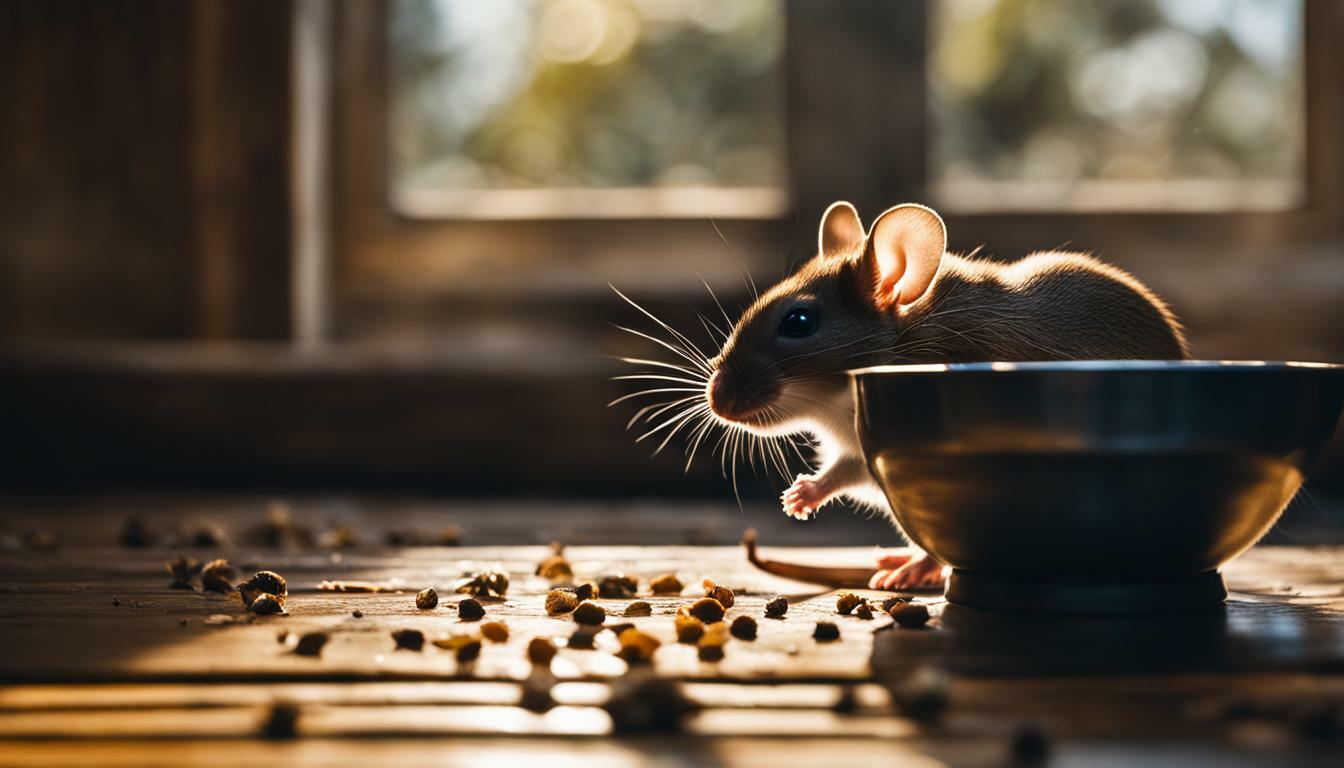Have you ever wondered if mice can drink from a bowl? In this section, we will explore this question and provide you with all the information you need to know about mice’s water sources.
Key Takeaways:
- Using a bowl as a water source for mice is not recommended due to potential contamination from bedding and debris.
- Water bottles are a better option for keeping mice’s water clean and hygienic.
- Mice can absorb water from their food, but it is essential to include hydrating fruits and vegetables in their diet.
- Glass water bottles are preferred over plastic ones as they are chew-proof and easier to clean.
- Some mice may initially struggle to drink from a bowl, but with patience and training, they can learn to do so.
Why Using a Bowl is Not Recommended for Mice
While it is possible for mice to drink from a bowl, it is generally not recommended due to certain drawbacks. One of the main concerns is that mice can easily contaminate the water with their bedding and other debris. As they explore their surroundings and create nests, they may inadvertently introduce dirt, droppings, or food particles into the water, posing health risks to themselves.
Keeping mice’s water clean and hygienic is crucial for their overall well-being. A contaminated water source can lead to bacterial growth, which can in turn cause diseases and infections. Additionally, if the water is not changed frequently, it may become stale or develop a foul odor, which mice are less likely to drink from.
Fortunately, there are alternative options that are more suitable for providing clean and hygienic water to mice. One of the most popular choices is using water bottles specifically designed for small animals. These bottles have a nozzle that allows mice to drink without contaminating the water. They also have the advantage of being easily refillable and less prone to spills.
| Benefits of Water Bottles for Mice: |
|---|
| Prevent contamination of water |
| Easily refillable and less prone to spills |
| Promote hygiene and cleanliness |
In addition to using water bottles, mice can also obtain water from their food. They have the ability to absorb moisture from fruits, vegetables, and other hydrating foods. Including these items in their diet can contribute to their overall hydration and reduce their reliance on a water bowl.
When providing water bottles, it is important to choose a chew-proof and easy-to-clean option. Glass water bottles are highly recommended for mice as they are more durable and resistant to damage. They are also easier to sanitize, ensuring a safe and healthy water source for your mice.
Alternatives to Bowl for Keeping Water Clean
Fortunately, there are better alternatives to bowls for providing water to your mice. Using water bottles can help keep their water clean and hygienic, minimizing the risk of contamination from bedding and debris. Water bottles offer several benefits over bowls, making them a preferred choice for mouse owners.
1. Hygienic and Convenient: Water bottles have a spout that dispenses water as the mice lick it, preventing them from contaminating the water with their bedding or droppings. This helps maintain a cleaner and healthier water source for your mice. Additionally, water bottles can hold a larger volume of water, reducing the frequency of refilling.
2. Glass Water Bottles: Glass water bottles are a great option for mice as they are chew-proof and easier to clean compared to plastic ones. Mice have a natural tendency to chew on objects, and plastic bottles can be easily damaged, leading to leaks or even potential health hazards if the mice consume the plastic. Glass bottles are sturdier and less likely to be damaged by chewing, ensuring a long-lasting water source for your furry friends.
3. Training Mice: While some mice may not initially know how to drink from a bowl, they can be trained to do so. Gradually introducing a shallow bowl of water alongside the water bottle can encourage mice to learn how to drink from it. Placing treats near the bowl can also help attract their attention and encourage exploration. With time and patience, mice can become accustomed to drinking from a bowl in addition to using the water bottle.
| Advantages of Water Bottles |
|---|
| Prevent contamination from bedding and debris |
| Hold a larger volume of water |
| Chew-proof and easy to clean (glass bottles) |
| Encourage mice to learn to drink from a bowl |
Mouse Hydration Needs and Food Sources
Understanding the hydration needs of mice is crucial for their overall well-being. Mice, like other animals, require water to survive and thrive. While they can drink from a bowl, it is not recommended due to the risk of contamination. Bedding and other debris from the enclosure can easily find their way into the water, posing potential health risks to the mice.
In addition to providing clean water, mice can also obtain water from their diet. They have the ability to absorb water from the food they consume. Including hydrating fruits and vegetables in their diet can contribute to their hydration needs. Cucumbers, lettuce, and watermelon are examples of hydrating foods that can help keep mice properly hydrated.
When it comes to providing water to mice, water bottles are a better option than bowls. Glass water bottles are particularly recommended because they are chew-proof and easier to clean. Mice have a tendency to chew on their surroundings, including plastic water bottles, which can lead to leakage or other issues. Glass water bottles offer a more durable and hygienic solution for providing water to mice.
Benefits of Glass Water Bottles:
- Chew-proof, preventing leakage and potential accidents
- Durable and long-lasting
- Easier to clean and maintain hygiene
- Allows for easy monitoring of water levels
By understanding the hydration needs of mice and providing them with clean water and hydrating foods, you can ensure their overall health and well-being. Opting for glass water bottles over bowls or plastic water bottles is a smart choice to keep their water supply clean and prevent any unwanted accidents or health issues.
| Fruits | Water Content |
|---|---|
| Cucumbers | Approximately 96% |
| Watermelon | Approximately 92% |
| Strawberries | Approximately 91% |
Teaching Mice to Drink from a Bowl
If you still prefer using a bowl as a water source, you can train your mice to drink from it. Although it is not the most recommended option, with patience and consistency, your mice can learn to drink from a bowl effectively. Here are some tips to help you in the training process:
- Choose a shallow bowl: Opt for a bowl that is shallow and wide, making it easier for your mice to access the water. Avoid bowls with steep sides that may make it challenging for them to reach the water.
- Place the bowl in a secure location: Ensure that the bowl is placed securely in the cage to prevent it from tipping over or becoming contaminated with bedding or debris.
- Offer familiar scents: To encourage your mice to approach the bowl, you can rub a piece of their bedding or place a small amount of their preferred food near the bowl. This will help them associate the bowl with familiar scents and positive experiences.
With time, your mice will become more accustomed to the bowl and learn to drink from it. However, it is essential to regularly monitor the water for any signs of contamination and replace it promptly to maintain their health.
Training Process
The training process may vary for each mouse, but here is a general step-by-step guide:
- Introduce the bowl: Place the bowl in the cage and allow your mice to familiarize themselves with it. You may notice curious behavior as they explore the bowl.
- Guide them to the water: Using a clean fingertip, gently dip it into the water and touch their noses to it. This will help them recognize the water as a source of hydration.
- Repeat and reinforce: Over time, continue guiding their noses to the water, gradually reducing your assistance. Reward their successful drinking attempts with praise and a small treat to reinforce the behavior.
- Monitor and adjust: Regularly check the bowl for cleanliness and refill it with fresh, clean water. Adjust the positioning of the bowl if necessary to ensure easy access for your mice.
| Training Tips: | Training Don’ts: |
|---|---|
|
|
Remember, while it is possible to train mice to drink from a bowl, water bottles are a more hygienic and recommended option. They help prevent the water from being contaminated and provide a consistent supply. Ultimately, ensuring your mice have access to clean and fresh water is crucial for their overall health and well-being.
Glass Water Bottles vs. Plastic Water Bottles
When choosing a water bottle for your mice, you may wonder whether to opt for glass or plastic. Both options have their advantages, but there are some key differences to consider.
Firstly, glass water bottles are chew-proof, which is important as mice have a natural instinct to gnaw on things. This means that glass bottles are more durable and less likely to be destroyed by your furry friends. Additionally, glass bottles are easier to clean, as they can be safely washed in hot water without the risk of warping or deteriorating.
On the other hand, plastic water bottles can be more affordable and lightweight. They are generally easier to find in stores and come in a variety of sizes and designs. However, it’s important to choose a high-quality plastic bottle that is BPA-free, as lower-quality plastics can leach harmful chemicals into the water.
In summary, glass water bottles are the recommended option for providing water to your mice. They are chew-proof, easier to clean, and offer a more durable solution. However, if you prefer the affordability and lightweight nature of plastic bottles, be sure to choose a BPA-free option to ensure the safety of your mice.
| Advantages of Glass Water Bottles | Advantages of Plastic Water Bottles |
|---|---|
| Chew-proof | Affordable |
| Easier to clean | Lightweight |
| Durable | Available in a variety of sizes and designs |
Conclusion
In conclusion, while mice can drink from a bowl, it is generally not recommended due to the potential for contamination. Mice have a tendency to contaminate their water with bedding and other debris, which can pose health risks. To ensure the cleanliness and hygiene of their water source, it is advisable to use water bottles as an alternative.
Water bottles provide a more secure and controlled environment for mice to drink from, significantly reducing the chances of contamination. They are designed to prevent mice from soiling the water, keeping it clean and safe for consumption. Additionally, water bottles are easier to clean and maintain, ensuring a continuous supply of fresh water for your furry friends.
It is important to note that mice can also obtain water from their diet. They have the ability to absorb water from the foods they consume, but it is still crucial to provide them with a separate source of clean drinking water. Including hydrating fruits and vegetables in their diet can further contribute to their hydration needs and overall well-being.
When choosing a water bottle for your mice, it is recommended to opt for glass bottles over plastic ones. Glass water bottles are chew-proof, preventing any potential damage that mice may cause. They are also easier to clean and sanitize, ensuring the highest level of cleanliness for your mice’s water supply.
While some mice may not initially know how to drink from a bowl, they can be trained over time with patience and perseverance. However, considering the potential for contamination and the convenience of water bottles, it is worth investing in a suitable water bottle for your mice’s health and comfort.
FAQ
Can mice drink from a bowl?
Yes, mice can drink from a bowl, but it is not recommended because they can easily contaminate the water with bedding and other debris.
Why is using a bowl not recommended for mice?
Using a bowl as a water source for mice is not recommended because they can easily contaminate the water with bedding and other debris, posing health risks to them.
What are the alternatives to using a bowl for keeping water clean?
Alternatives to using a bowl for keeping water clean include water bottles, which are a better option for mice as they help maintain the water’s cleanliness and hygiene.
How do mice obtain water from their diet?
Mice can absorb water from their food, but they can also benefit from hydrating fruits and vegetables in their diet to ensure optimal hydration.
Can mice be trained to drink from a bowl?
Yes, some mice may not initially know how to drink from a bowl, but they can be trained to do so with proper guidance and encouragement.
Are glass water bottles better than plastic ones for mice?
Glass water bottles are recommended over plastic ones for mice because they are chew-proof and easier to clean, ensuring the water remains hygienic.




